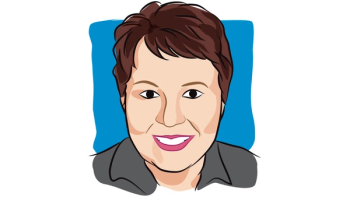
The Chemo Christmas Tree: The End of a Cancer Tradition
A beloved tradition at a local hospital disappears.
On July 25, I go see my oncologist for a routine six-month checkup. All of the stores are featuring "Christmas in July" sales. I'm going to avoid these. I have enough things. What I need is peace of mind.
I am planning to ask my oncologist about the possibility of my two prior cancers metastasizing. I am feeling a little like a ticking time bomb, wondering if either of the cancers is going to reappear. I am seven years out from the first breast cancer occurrence and three years out from my second. I don't always feel like this, but for some reason, today I am pessimistic and scared.
After a brief time in the waiting room, a nurse takes me back and puts me in room number 5. "Please don't shut the door," I tell her after she's taken my vitals and updated my medical history and medication list. I've inherited claustrophobia from my maternal grandmother. The nurse obliges me.
While I wait for my doctor, I ponder a recent change that has occurred in the chemotherapy waiting room next door. I always stop in this waiting room to view the Christmas tree that someone decorates for every holiday. The “chemo Christmas tree” makes me happy. Around Valentine's Day, it's decorated with hearts. And at St. Patty's Day, it's covered in green shamrocks. In the spring, colorful artificial flowers adorn the branches, etc., etc., etc.
The tree is for people who might not make it to next Christmas.
But that day, it wasn't there. It was gone.
A surge of panic ran through me. Where's the Christmas tree?
I looked all over the chemo waiting room. Was I missing something? I even looked for it in the cancer library across the hall.
The chemo Christmas tree was definitely gone.
"What happened to the Christmas tree?" I asked the receptionist
"The lady who decorates it couldn't keep it up,” she replied. “It was 'stuck' on Thanksgiving for a while. We knew that didn't make sense to our patients so we took it down until the woman can take care of it again."
"Well, I hope it's back soon,” I said. “That tree means a lot to me."
"Yes,” the receptionist said, “it means a lot to many people. At the very least, it brings a smile to their faces."
Everything changes, I think to myself as I pick up a Good Housekeeping magazine. Nurses and doctors race by room number 5. I can view the hustle of activity through my open door.
Soon, my oncologist appears. I love seeing her. She's pulled me through two life-or-death scenarios. She's also a good egg; someone I'd run around with in an alternative universe where I didn't have cancer issues. We're about the same age. We've seen some of the same things.
She tells me to undress and then does a tactile examination of both breasts. "Looks good," she says.
"Thank God," I say, feeling as though a weight has been lifted from my shoulders.
About halfway into my exam, although things look fine, I ask her about metastasis.
"If your first cancer comes back, it will appear in your liver, your lungs or your bones. If the second does, it will appear in your lungs."
Well, there it is.
"How will I know if it's in my lungs?" I asked.
"You'll develop a bad, persistent cough," my oncologist answered.
At least I know now what to watch for. Surprisingly, knowing the facts makes me feel better. I am now more educated. This is a gift in itself.
I drive home, calling my loved ones to relay the news.
Folks with cancer: if you have questions about your illness, ask. It's better to know than not to know. Even if the news isn't great.
And Merry Christmas in July.





